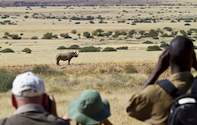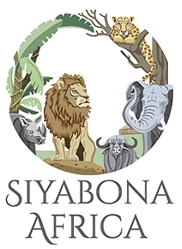
The 450,000 hectare Palmwag Conservancy is managed by Save the Rhino Trust, an organisation that had extremely tenuous beginnings but which is now the custodian of the most viable population of these amazing desert-adapted animals.
The lodges, however, is run by Wilderness Safaris, In the mid-1980s the Namibian Wildlife Society, led by feisty Blythe Loutit and her noble band of wildlife warriors formed the trust. At first funding for the project came through extremely slowly and then mainly from schoolchildren. But eventually, more able finance came about and today the trust is the backbone of conservation in northern Namibia. In 2002 Wilderness Safaris acquired a stake in the concession and built their camp, one that has among the very lightest earth touches of any safari destination you will find.
What is more, the community conservation blueprint developed here and at several similar conservancies in the region, has been adopted by the Namibian government as the model for the entire country. Today the trust employs ex-poachers among its rhino trackers and guardians, and who better!
Sometimes you will be lucky and find desert black rhinos hanging around close to camp. On other occasions, you might have to drive for up to nine bone-jarring hours before the trackers locate their quarry. The anticipation rises as they travel back and forth looking for tracks. You can sense their excitement when they get a lock on rhino spoor and you feel an engagement is not far off.
Scanning the terrain you may see the outline of a rhino emerge from the landscape like a totally improbable creature that could have been dreamed up by Alice in Wonderland, as much as in Gondwana - Rhinosaurus biceratops perhaps. In times after good rains, the land will 100k most pleasing to / the eye, covered by a silky pelt of pallid-golden grass. As you set along the 4x4 tracks (the land looking for all the world like wheat fields) the chill early morning air can suddenly erupt in a spray of larks and sparrowlarks in their hundreds, the sight and sound like feathered insects, a whirring mass of little wing beats.
Damaraland is unquestionably a great safari destination for large mammals, but equally so for those fixated on birding. Ostriches and raptors are the most obvious and conspicuous, followed by robust, strutting bustards such as Rüppell's korhaan (their guttural croaking sounds like frogs courting). Other birds specific to the arid regions include Temminck's courser and Namaqua sandgrouse. But dedicated twitchers will have the endemic "specials" including Monteiro's hornbill, Herero chat and Bengugla long-billed lark at the tops of their lists.
No plant of the Namib Desert is more striking than the 'miraculous" welwitschia ( Welwitschia mirabilis). It is a veritable dinosaur of the vegetable world, looking as though it too has slipped the cordon of Jurassic Park. The bizarre looking plants grow on the gravel plains and adjacent rocky hillsides; with just two leathery leaves emerging from a woody mass (the dead remains look like fossil heads on the desert floor). These two leaves grow throughout the plant's life, which might be several hundred years or more, and they are continuously
Much like desert rhinos, the welwitschia is something of a remainder from antediluvian times, Its survival here is enabled by a fine network of root hairs that greedily suck up any moisture that condenses from regular sea fogs (the life blood of the region), as well as a very long tap root that hungrily searches for any available ground water. Little wonder that this hardy reli has been adopted as the national plant of Namibia.

 Desert Rhino Camp offers one of the most exciting Namibia safaris in rugged northern Damaraland. Partnership with Save the Rhino Trust - R...
Desert Rhino Camp offers one of the most exciting Namibia safaris in rugged northern Damaraland. Partnership with Save the Rhino Trust - R...